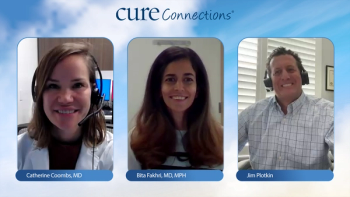
Shared Decision-Making in NSCLC
The significance of shared decision-making between patients and lung oncologists when considering a novel-based therapy as treatment for non-small cell lung cancer.
Episodes in this series

Charu Aggarwal, M.D., MPH: This leads us to some of the management of the side effects, because these therapies are often associated with a completely different side effect profile. Along with my support in the clinic, my advanced practice provider, clinic nurses, as well as clinical research staff, we spend a lot of time talking about management of immune-related side effects. We talked a little about how we select patients, but do you feel like your patients are very involved in the choice of I/O [immunotherapy] therapy, or most of the time do you feel like you’re saying, “I think this is my best recommendation,” and then they come back and ask, “But how about this?” How does it work out for you? How do you discuss side effect management?
Hossein Borghaei, DO, MS: That’s a really good question. The more information a patient and family members have, the easier it is for them to understand the path we’re taking, so it becomes a joint decision they can process. If you mean by the choice of checkpoint inhibitor, like the various different drugs, I usually just mention that there are many different drugs. But, like most of us in the field of oncology, I feel comfortable with a specific drug or combination, and it’s always my go-to. There’s no reason beyond that of choosing and sticking with one regimen or one drug over anything else. If a patient has a significant preference toward a different checkpoint inhibitor, as long as there are data available for it, I’m more than happy to accommodate. But having the discussion ahead of time to say, “I’m going with what I’m recommending based on my familiarity with the drug or the combination,” is very helpful.
The overwhelming majority of data that we’ve looked at don’t indicate a significant preference for one checkpoint inhibitor versus the other, so I can’t tell a patient that one checkpoint inhibitor is significantly more toxic than the other. That’s not what we’ve seen. But if a patient has a specific preference to use one particular drug, as long as there are data available and all of that, then I’m OK with changing treatment. But in my mind, I’ve selected one checkpoint inhibitor I’m familiar with, I know how it works, I know I can combine it with different things, and that’s what we go to.
You talked about the I/O-I/O combination, and that’s a distinction. I have to qualify that by saying the I/O-I/O combination is not something that a lot of our colleagues have chosen to go with, simply because the combination of two I/O agents can sometimes be a little more toxic than the chemotherapy combination, or at least that’s the perception. Although the data, in my view, don’t really show that necessarily. Discussing all of these options with the patient at the same time as you’re going through the molecular testing is important. We usually provide consent forms with the information regarding the drug, and we allow patients to review all of that, take it home, and discuss it with their family members or other physicians so that the next time we meet, there’s a better informed discussion as to why we want to do the things we want to do.
Transcript edited for clarity.


